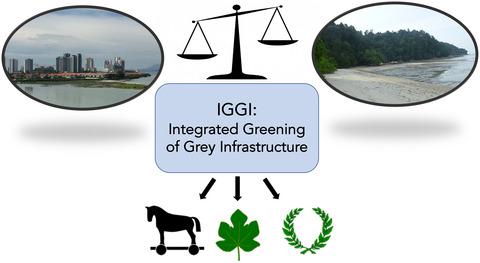当前位置:
X-MOL 学术
›
J. Appl. Ecol.
›
论文详情
Our official English website, www.x-mol.net, welcomes your feedback! (Note: you will need to create a separate account there.)
Greening of grey infrastructure should not be used as a Trojan horse to facilitate coastal development
Journal of Applied Ecology ( IF 5.7 ) Pub Date : 2020-06-21 , DOI: 10.1111/1365-2664.13683 Louise B. Firth 1 , Laura Airoldi 2 , Fabio Bulleri 3 , Steve Challinor 4 , Su‐Yin Chee 5 , Ally J. Evans 6 , Mick E. Hanley 1 , Antony M. Knights 1 , Kathryn O'Shaughnessy 1 , Richard C. Thompson 1 , Stephen J. Hawkins 7, 8
中文翻译:

灰色基础设施的绿化不应被用作特洛伊木马,以促进沿海发展
更新日期:2020-06-21
Journal of Applied Ecology ( IF 5.7 ) Pub Date : 2020-06-21 , DOI: 10.1111/1365-2664.13683 Louise B. Firth 1 , Laura Airoldi 2 , Fabio Bulleri 3 , Steve Challinor 4 , Su‐Yin Chee 5 , Ally J. Evans 6 , Mick E. Hanley 1 , Antony M. Knights 1 , Kathryn O'Shaughnessy 1 , Richard C. Thompson 1 , Stephen J. Hawkins 7, 8
Affiliation

|
- Climate change and coastal urbanization are driving the replacement of natural habitats with artificial structures and reclaimed land globally. These novel habitats are often poor surrogates for natural habitats.
- The application of integrated greening of grey infrastructure (IGGI) to artificial shorelines demonstrates how multifunctional structures can provide biodiversity benefits whilst simultaneously serving their primary engineering function. IGGI is being embraced globally, despite many knowledge gaps and limitations. It is a management tool to compensate anthropogenic impacts as part of the Mitigation Hierarchy. There is considerable scope for misuse and ‘greenwashing’ however, by making new developments appear more acceptable, thus facilitating the regulatory process.
- We encourage researchers to exercise caution when reporting on small‐scale experimental trials. We advocate that greater attention is paid to when experiments ‘fail’ or yield unintended outcomes. We advise revisiting, repeating and expanding on experiments to test responses over broader spatio‐temporal scales to improve the evidence base.
- Synthesis and applications. Where societal and economic demand makes development inevitable, particular attention should be paid to avoiding, minimizing and rehabilitating environmental impacts. Integrated greening of grey infrastructure (IGGI) should be implemented as partial compensation for environmental damage. Mutual benefits for both humans and nature can be achieved when IGGI is implemented retrospectively in previously developed or degraded environments. We caution, however, that any promise of net biodiversity gain from new developments should be scrutinized and any local ecological benefits set in the context of the wider environmental impacts. A ‘greened’ development will always impinge on natural systems, a reality that is much less recognized in the sea than on land.
中文翻译:

灰色基础设施的绿化不应被用作特洛伊木马,以促进沿海发展
- 气候变化和沿海城市化正在推动全球以人工结构和开垦土地取代自然栖息地。这些新颖的栖息地通常是自然栖息地的替代品。
- 灰色基础设施的集成绿化(IGGI)在人工海岸线上的应用展示了多功能结构如何在为生物多样性带来好处的同时又能发挥其主要的工程功能。尽管存在许多知识空白和局限性,但IGGI已在全球范围内受到欢迎。它是一种管理工具,可作为缓解层次结构的一部分来补偿人为影响。然而,通过使新的发展看起来更容易被接受,滥用和“绿色清洗”的范围很大,从而促进了监管程序。
- 我们鼓励研究人员在报告小规模实验研究时要谨慎。我们主张,当实验“失败”或产生意想不到的结果时,应给予更多的关注。我们建议重新审视,重复和扩展实验,以测试更广泛的时空范围内的响应,以改善证据基础。
- 综合与应用。在社会和经济需求使发展不可避免的情况下,应特别注意避免,减少和恢复环境影响。灰色基础设施(IGGI)的综合绿化应作为对环境破坏的部分补偿而实施。当在先前开发或退化的环境中追溯实施IGGI时,可以实现对人类和自然的共同利益。但是,我们告诫,应仔细审查任何从新发展中获得净生物多样性收益的承诺,并应在更广泛的环境影响的背景下确定任何当地的生态效益。“绿化”发展将始终冲击自然系统,这一事实在海洋中比在陆地上要少得多。



























 京公网安备 11010802027423号
京公网安备 11010802027423号